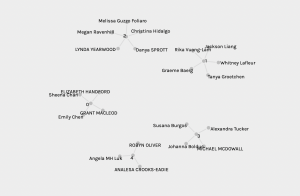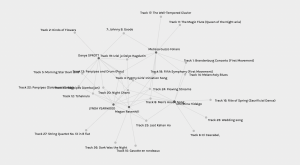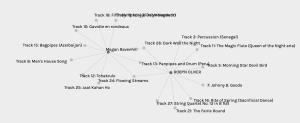Task 9: Network Assignment Using Golden Record Curation Data
Task 9 took a deep look into data interpretations and connections through the Golden Record data ETEC 540 completed last week (song selections). The instructors took the data and entered it into a software called, Palladio. I have zero experience with Palladio and data viewing as a whole, so I found this task fairly difficult to start. However, once I spent time exploring Palladio, I was able to grasp the task a little bit better.
There are several things I have learned throughout this module and task. For example, the video from System Innovations (2015) about Graph Theory introduced the idea that a network is also called a graph, which contain vertex, nodes, verticals, and edges. I have seen these graphs in the past, however, I never took the time to understand the meaning or lack of meaning of these connecting lines.
The following are a few screenshots of different ways to look at the data:
 (Image 1: Using Source – Curators & Target – Community)
(Image 1: Using Source – Curators & Target – Community)
From this view, I can see that I am part of community #2 alongside four other classmates. I started with this view as I was trying to understand how and where I was represented within the graph. This view represents an undirected graph as there is no indication of which affects what (System Innovations, 2015).

(Image 2: Using Source – Curators & Target – Tracks, focusing on community 2 results)
Using these parameters, I am able to see that my classmate, Lynda, and I have several similar connections between nodes (in this case, music tracks), more specifically, a sequence of adjacent connections (Systems Innovations, 2015). However, although this shows similar track choices, this doesn’t necessarily produce a reason why. Furthermore, this view of the graph represents that I do not have edges between Track 1: Brandenburg Concerto (First Movement), however, there is an undirected connection between different nodes and myself that eventually connect to Track 1.

(Image 3: Looking at the connection between 1 classmate and myself through similar and different track choices)
This view allows me to analyze the similar choices made between myself and ETEC 510 classmate, Robyn. Surprisingly, we only chose three similar tracks. I wanted to find someone who had less than 5 similar choices and Robyn was one of the only people to have so few. This image could potentially explain why these choices are similar if more research into the individual’s understanding and knowledge of music genres, cultures, instruments, etc… However, without further research, we could assume some of these ideas but we would be left with limited clarity.
I believe if you were to look at each students grouping individually and write down facts of each, we could understand the “null” choices by making connections to what they did choose and what they did not. However, there is missing information. For example, connections between two different students based on their similar track choices lack data, the students do share a track choice, however, this could have been person A’s first choice and person B’s last choice. This does make a difference as researchers looking into this data would assume that a similar choice was made because of the like of the song, however, it could actually be because it was their last choice which may have resulted in less strategy or selection.
Algorithms are constantly working through the common apps we use everyday, Instagram, Facebook (Meta), Youtube, etc… We see things because the technological world makes connections out of nodes, therefore, forcing you to see what you want to see (example: you click on things about cats, you are most likely going to be seeing advertisements for cats or cat accessories). The internet has formulated into wanting to find connections for the users. Considering Anderson’s and Raine’s article, Code-Dependent: Pros and Cons of the Algorithm Age”, (2017), Barry Chudakov states;
“The secondary positive result is connectivity. In a technological recapitulation of what spiritual teachers have been saying for centuries, our things are demonstrating that everything is – or can be – connected to everything else”.
Therefore, the whole idea of algorithms is to make connects, pathways, and decisions. However, it is up to us what information we allow these ‘robots’ to implement into these algorithms. After doing a little more research, I started to wonder about the following questions:
- If algorithms create connections to things we click, watch, and see, what are we not able to click, watch, and see, because of it?
- Will there ever be a way to avoid algorithms on the internet?
References:
Rainie, Lee and Janna Anderson, “Code-Dependent: Pros and Cons of the Algorithm Age. Pew Research Center, February 2017. Available at: http://www.pewinternet.org/2017/02/08/code-dependent-pros-and-cons-of-the-algorithm-age
Systems Innovation. (2015, April 18). Graph Theory Overview. Retrieved from https://youtu.be/82zlRaRUsaY
Systems Innovation. (2015, April 19). Network Connections . Retrieved from https://youtu.be/2iViaEAytxw